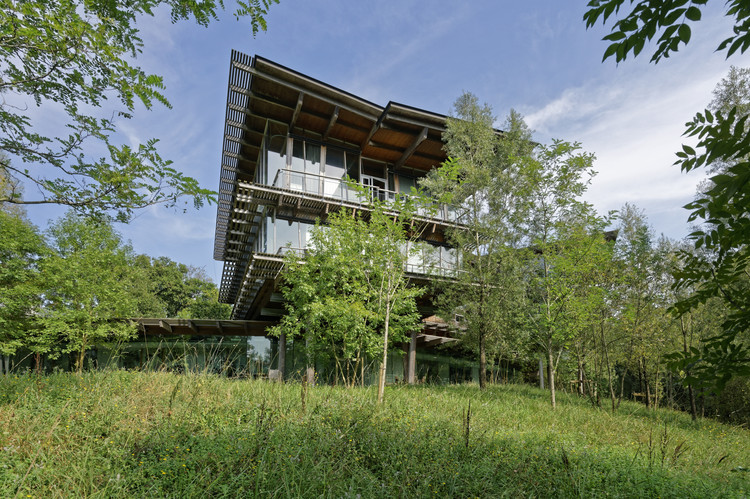Museum of the Atacama Desert Coz, Polidura - Volante Arquitectos
2013-08-22 01:00


阿塔卡马沙漠博物馆位于瓦卡卡遗址脚下,这是智利北部安托法加斯塔市南部的一座银色地基。
The Museum of the Atacama Desert is located at the feet of the Huanchaca Ruins, a silver foundation in the south of the city of Antofagasta, north of Chile.
该遗址是1974年以来的一座国家纪念碑,因此构成了起点,为博物馆最终采取的战略制定了一个纲要。
The ruins are a national monument since 1974, therefore constituting the starting point, which sets an outline in order to create the strategy that was finally adopted for the museum.










其主要目标是对废墟进行估价,并使之脱颖而出,采用的是实心砖石,符合简单的可识别体积和具有巨大规模的墙壁,追溯到1902年完成其工业功能的白色海滩银铸造厂。
The main objective is to value the ruins and make them stand out using solid masonry conforming simple identifiable volumes and walls of monumental scale that trace the White Beach silver foundry that finished its industrial functions in 1902.
体积和数学节奏是由废墟通过空洞和沉重的聚集形状来表达的,这些形状被转化为构成博物馆东西轴的五个猖獗的房间的几何形状。
Volumes and mathematical rhythms are expressed by the ruins through voids and heavy massed shapes that were translated into the geometry of the five rampant rooms that compose the east-west axis of the museum.


同时,这两卷书将地势中现存的两个梯田连在一起,目的是在纪念碑下建造一个基地,而不是干扰建筑框架有意指向的景观,从而在整个华卡卡文化公园中产生流畅感。
At the same time these volumes connect the two existing terraces in the terrain. This operation is intended in order to construct a base under the monument, not interfering with the views that are directed intentionally by framing in the architecture and thus generating fluentness throughout the cultural park of Huanchaca.
博物馆内部有五个永久性展览室,其中两个仅用于阿塔卡马的地质沙漠,另外两卷专门用于采矿工业和智利第一批北方居民。最后一个房间专门用于外层空间,由南欧天文台捐赠。
Inwardly the Museum contains five permanent exhibition rooms, two of them are dedicated only to the geological desert of Atacama, two other volumes are dedicated to the mining industry and the first northern inhabitants of Chile. One last room is dedicated to the outer space containing donations by the Southern European Observatory.
© Sergio Pirrone
c.塞尔吉奥·皮尔龙




在北面有一个门厅,是一个专为博物馆临时展览和扩建活动而设的门厅。这一空间在视觉上连接着,并与废墟有关,穿过一条长长的裂缝,可以俯瞰博物馆内部的一切辉煌。
At the north access a vestibule conforms the Huanchaca Room, a space dedicated to temporary exhibitions and activities of extension of the Museum. This space connects visually and relates to the ruin through a long gash that permits views toward the pre-existence and all its splendor while still being in the interior of the Museum.
三个露台通过创造交叉通风来解决气候控制问题,其中一个包含了博物馆的技术方面。这些露台还在视觉上定义了建筑物的内部,并将其与突出的废墟联系起来,从而重申了该项目的主要目标。
Three patios resolve the climatic control by creating crossed ventilations and one containing technical aspects of the Museum. These patios also define and relate visually the interior of the building with the ruins that stand out, reaffirming the main goal of the project.
© Sergio Pirrone
c.塞尔吉奥·皮尔龙










北边的第一个露台,通过该机构提供的保护和博物馆设计工作,与游客联系在一起。
The first patio to the north, relates with the visitor through the conservation and museography work the institution has to offer.
通过大窗玻璃,第二个露台扩展并连接到听觉的前厅,可容纳100人,面向咖啡厅前部、纪念品店和博物馆公共区域的服务区。
Through large windowpanes the second patio expands and connects to the vestibule of the auditory, with capacity for a hundred people facing the front of the cafe, a souvenir shop and the service area that ends the museum´s public area.


这一操作将博物馆建筑项目的这些元素转换为中间空间,这样就可以避免严苛的热量,将它们变成通风良好的空间。
This operation converts these elements of the architecture program of the museum into intermediate spaces that allow the rigorous heat to escape turning them into ventilated and well aired spaces.
最后的露台完全致力于建筑的技术方面,将它们集中在这个空间中,并用光栅将它们定位在适合居住的盖子下。出于安全原因,这一地区得到了广播和保护。
The final patio is completely dedicated to the technical aspects of the building, concentrating them in this space and locating them under the habitable cover with grating. This area is aired up and protected for security reasons.
建筑物的通风和设施集中在一个垂直的混凝土单体上,消除了任何可能干扰废墟盖和视图之间的视觉关系的因素,赋予了逃避建筑物水平渴望的唯一元素-感官。
The ventilations and installations of the building are grouped on a vertical concrete monolith that eliminates any element that could disturb the visual relation between the cover and the views to the ruins, endowing with sense the only element that escapes the horizontal eagerness of the building.
适宜居住的覆盖层为纪念碑提供了一扇窗户,另一方面又将博物馆与海洋连接起来,重申了地形中的陡峭地形与位于华卡卡文化公园以西的斜坡之间的永久关系。
The habitable cover delivers a window to the monument and on the other hand connects visually the museum with the sea, reaffirming the permanent relationship between the abrupt topography presented in the terrain and the slope located west of the Huanchaca Cultural Park
© Sergio Pirrone
c.塞尔吉奥·皮尔龙

























































































Architects Ramon Coz Rosenfeld, Marco Polidura Alvarez, Eugenia Soto Cellino, Ignacio Volante Negueruela
Location Av. Angamos 1307, Antofagasta, Antofagasta, Región de Antofagasta, Chile
Category Monuments
Project Year 2009
Photographs Sergio Pirrone, CPVARQ, Karin Hofert
Manufacturers Loading...















.jpg)








